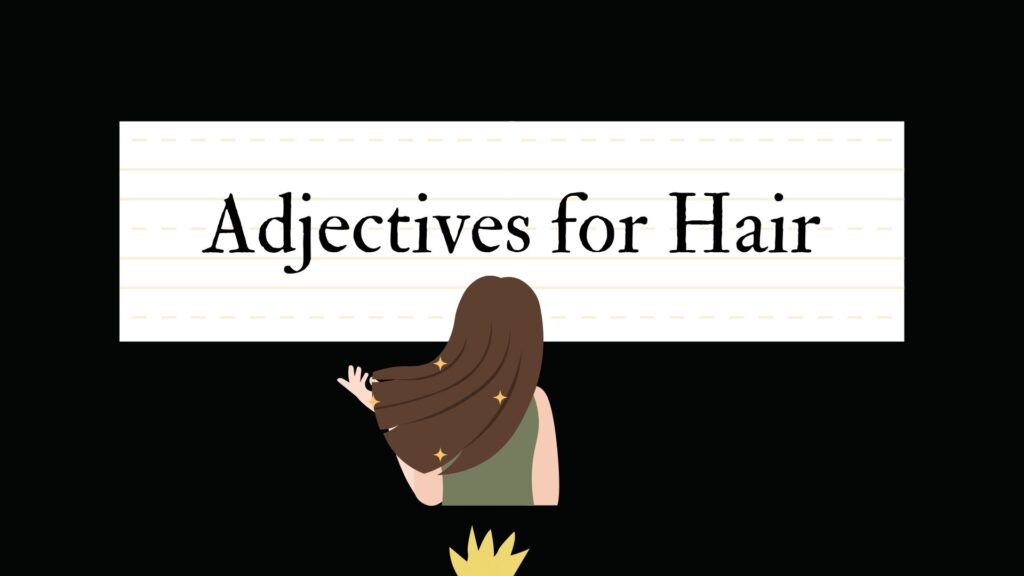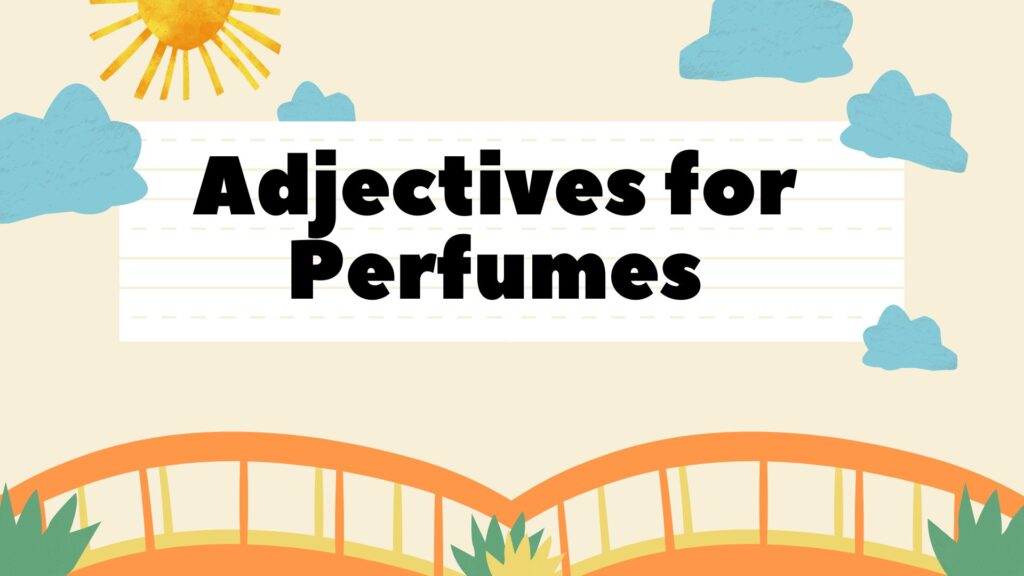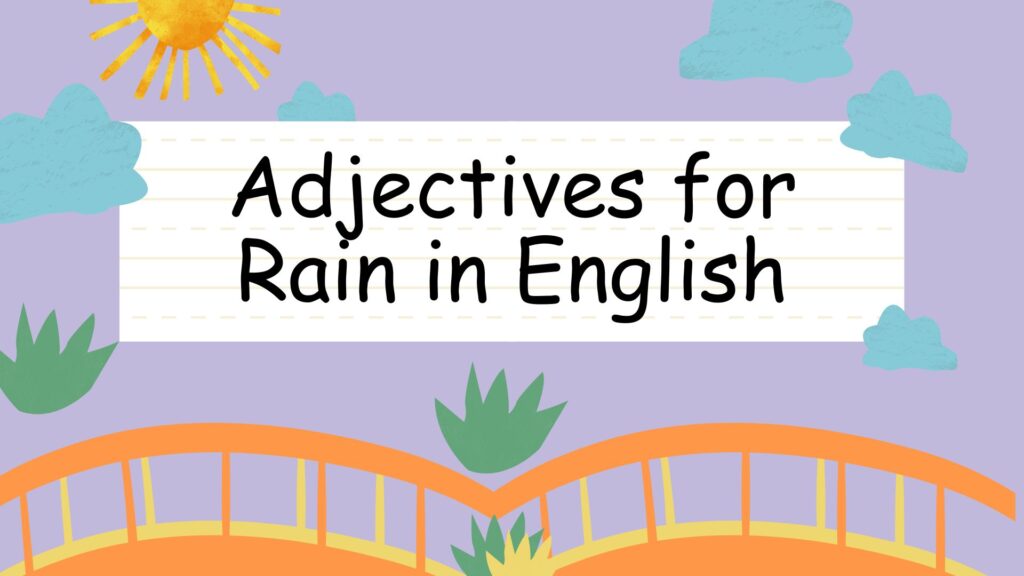Describing someone’s hair is more than just saying “long” or “short.” A rich vocabulary of adjectives allows you to paint a vivid picture, conveying not only the length and color but also the texture, style, and overall condition of the hair. This article provides a comprehensive guide to adjectives for hair, equipping you with the tools to describe hair with precision and flair. Whether you’re a student learning English, a writer crafting a character, or simply someone who wants to express themselves more effectively, this guide will prove invaluable.
Table of Contents
- Introduction
- What are Adjectives for Hair?
- Structural Breakdown: Adjectives in Sentences
- Types and Categories of Hair Adjectives
- Examples of Hair Adjectives in Use
- Usage Rules for Hair Adjectives
- Common Mistakes with Hair Adjectives
- Practice Exercises
- Advanced Topics: Figurative Language and Nuance
- Frequently Asked Questions
- Conclusion
What are Adjectives for Hair?
Adjectives for hair are words that describe the characteristics of a person’s hair. These adjectives provide specific details about various aspects of hair, such as its color, length, texture, style, condition, and quantity. They add depth and detail to descriptions, allowing for a more vivid and precise portrayal of someone’s appearance. Understanding and using these adjectives effectively enhances both written and spoken communication.
Adjectives, in general, are a fundamental part of English grammar. They modify nouns, providing additional information about them. In the context of hair, adjectives can transform a simple statement like “She has hair” into a much more descriptive one, such as “She has long, flowing, auburn hair.” The choice of adjectives significantly impacts the image conveyed and the level of detail provided.
The function of hair adjectives is primarily descriptive. They help to distinguish one person’s hair from another’s, or to highlight specific features of a particular hairstyle. The context in which these adjectives are used can vary widely, from everyday conversations to formal writing. For example, you might use simpler adjectives like “brown” or “short” in casual conversation, while a novelist might employ more evocative language like “raven” or “cascading” to create a more dramatic effect.
Structural Breakdown: Adjectives in Sentences
Adjectives typically appear before the noun they modify. This is known as the attributive position. For example:
- She has curly hair.
- He sported long, unkempt hair.
- The model had shiny, black hair.
In these examples, the adjectives “curly,” “long,” “unkempt,” “shiny,” and “black” all precede the noun “hair.” Multiple adjectives can be used to describe the same noun, often separated by commas. The order of these adjectives can sometimes follow general guidelines, such as opinion before fact, but in the case of hair, the order is often based on what sounds most natural.
Adjectives can also appear after a linking verb, such as “is,” “are,” “was,” “were,” “seems,” or “appears.” This is known as the predicative position. For example:
- Her hair is blonde.
- His hair seems thinning.
- Their hair was immaculate.
Here, the adjectives “blonde,” “thinning,” and “immaculate” follow the linking verbs “is,” “seems,” and “was,” respectively. In the predicative position, the adjective describes the subject of the sentence.
Sometimes, participles (verb forms ending in -ing or -ed) can function as adjectives. For example:
- She has flowing hair. (present participle)
- He has braided hair. (past participle)
In these cases, “flowing” and “braided” act as adjectives, describing the state or style of the hair.
Types and Categories of Hair Adjectives
Adjectives for hair can be categorized based on the specific aspect of the hair they describe. These categories include color, length, texture, style, condition, and quantity. Understanding these categories helps in choosing the most appropriate adjective for a given situation.
Adjectives for Hair Color
These adjectives describe the hue of the hair. They range from basic colors to more nuanced shades.
Examples include: black, brown, blonde, red, auburn, ginger, gray, white, silver, golden, platinum, strawberry blonde, brunette, dark brown, light brown, ash blonde, honey blonde, raven, jet black, chestnut, mahogany.
Adjectives for Hair Length
These adjectives specify how long the hair is.
Examples include: short, long, medium-length, shoulder-length, waist-length, ankle-length, cropped, bobbed, shaggy, layered, chin-length, pixie cut, buzz cut, flowing, cascading, knee-length, floor-length, uneven, asymmetrical.
Adjectives for Hair Texture
These adjectives describe the feel and appearance of the hair.
Examples include: straight, curly, wavy, coiled, kinky, frizzy, smooth, silky, coarse, fine, thick, thin, dry, oily, greasy, lustrous, dull, wiry, soft, manageable, unmanageable.
Adjectives for Hair Style
These adjectives describe how the hair is arranged or styled.
Examples include: braided, updo, ponytail, bun, dreadlocks, cornrows, bouffant, beehive, tousled, sleek, spiky, messy, neat, styled, unstyled, coiffed, crimped, permed, relaxed, natural, artificial.
Adjectives for Hair Condition
These adjectives describe the health and appearance of the hair.
Examples include: healthy, damaged, shiny, dull, vibrant, lifeless, strong, weak, brittle, split-ended, well-maintained, neglected, nourished, dry, hydrated, lustrous, tangled, smooth, manageable, unruly.
Adjectives for Hair Quantity
These adjectives describe the amount of hair a person has.
Examples include: thick, thin, full, sparse, abundant, voluminous, wispy, bald, balding, thinning, dense, plentiful, meager, profuse, luxuriant, scant, straggly, patchy, tufty, downy.
Examples of Hair Adjectives in Use
The following tables provide examples of how these adjectives can be used in sentences to describe hair effectively.
Color Examples
This table provides examples of adjectives describing hair color, showcasing their usage in sentences.
| Adjective | Example Sentence |
|---|---|
| Black | She has long, black hair that shines in the sun. |
| Brown | His brown hair was neatly combed. |
| Blonde | The child had blonde, curly hair. |
| Red | Her red hair stood out in the crowd. |
| Auburn | He admired her auburn, flowing hair. |
| Ginger | The woman with ginger hair smiled warmly. |
| Gray | His gray hair showed his age. |
| White | She had white hair, but her eyes sparkled with youth. |
| Silver | The actor sported silver hair for his role. |
| Golden | Her golden hair caught the light. |
| Platinum | The pop star had platinum blonde hair. |
| Strawberry Blonde | She dyed her hair a strawberry blonde shade. |
| Brunette | The brunette actress was known for her elegance. |
| Dark Brown | He had short, dark brown hair. |
| Light Brown | Her light brown hair framed her face perfectly. |
| Ash Blonde | The model’s ash blonde hair was very trendy. |
| Honey Blonde | She loved her honey blonde highlights. |
| Raven | Her raven hair cascaded down her back. |
| Jet Black | He had jet black hair and piercing blue eyes. |
| Chestnut | The horse had a chestnut mane. |
| Mahogany | The antique table had a rich mahogany color, similar to her hair. |
| Salt-and-pepper | His salt-and-pepper hair gave him a distinguished look. |
| Ombre | She sported ombre hair, transitioning from dark roots to blonde tips. |
| Dyed | Her dyed blue hair was a statement of her individuality. |
| Bleached | He had bleached blonde hair, a stark contrast to his dark eyebrows. |
| Highlighted | Her highlighted hair added dimension to her hairstyle. |
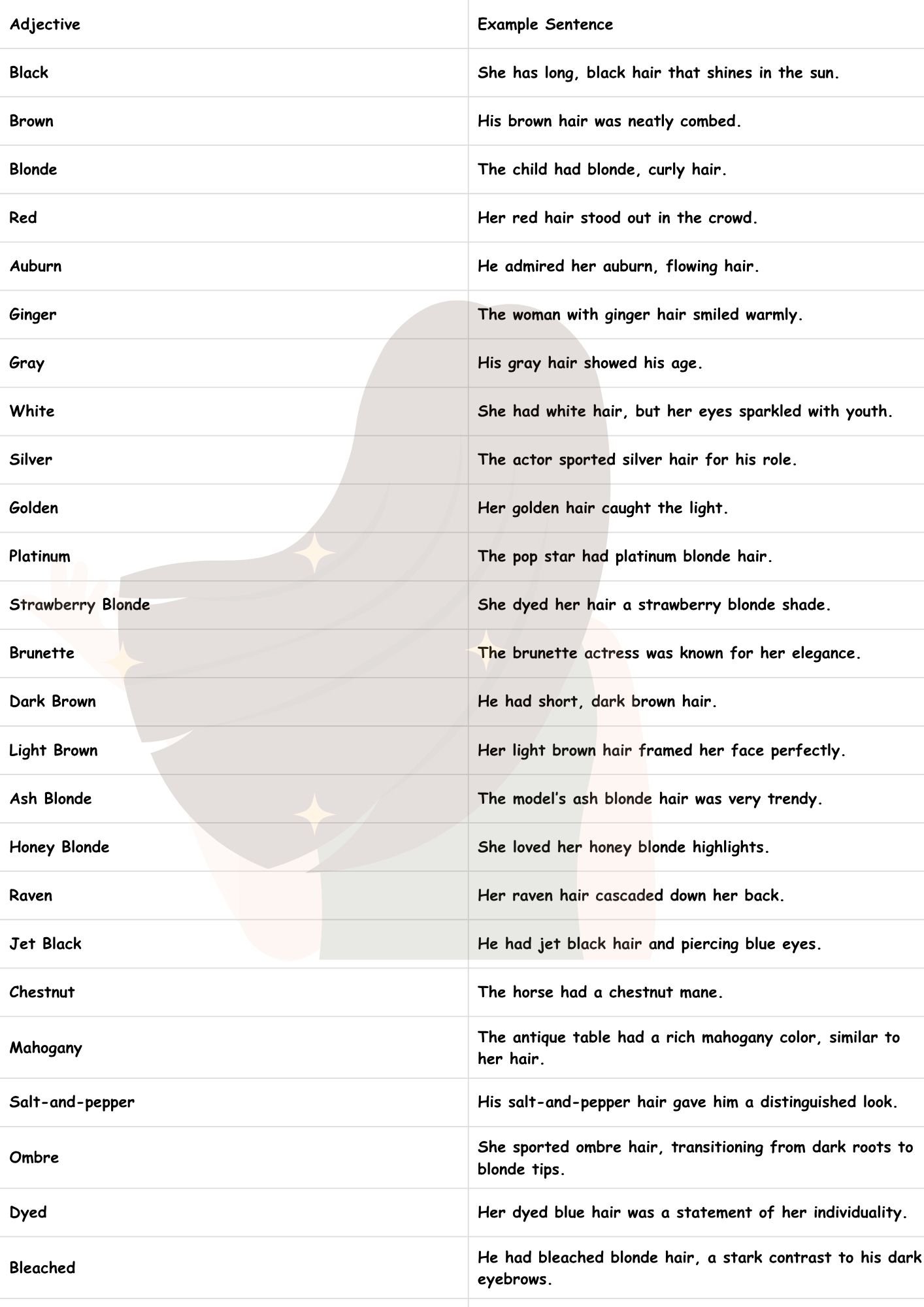
Length Examples
This table provides examples of adjectives describing hair length, showcasing their usage in sentences.
| Adjective | Example Sentence |
|---|---|
| Short | She prefers to keep her hair short and manageable. |
| Long | Her long hair flowed down her back like a waterfall. |
| Medium-length | He has medium-length hair that he styles with gel. |
| Shoulder-length | She wears her shoulder-length hair in loose waves. |
| Waist-length | She twirled her waist-length hair absentmindedly. |
| Ankle-length | The mythical creature had ankle-length silver hair. |
| Cropped | She decided to get a cropped haircut for the summer. |
| Bobbed | Her bobbed hair gave her a modern look. |
| Shaggy | He had shaggy hair that fell over his eyes. |
| Layered | Her layered hair added volume and movement. |
| Chin-length | The actress sported a chic chin-length bob. |
| Pixie cut | She rocked a bold pixie cut. |
| Buzz cut | He got a buzz cut before joining the military. |
| Flowing | Her flowing locks were the envy of everyone. |
| Cascading | She had cascading hair that reached her lower back. |
| Knee-length | The fairy tale princess possessed knee-length, golden hair. |
| Floor-length | The bride’s floor-length hair was intricately braided. |
| Uneven | His intentionally uneven haircut gave him an edgy appearance. |
| Asymmetrical | Her asymmetrical bob was a stylish choice. |
| Tapered | He got a tapered haircut that was shorter in the back. |
| Long and Luscious | She always took great care of her long and luscious hair. |
| Short and Spiky | His short and spiky hair reflected his rebellious personality. |
| Medium and Wavy | She preferred wearing her medium and wavy hair down. |
Texture Examples
This table provides examples of adjectives describing hair texture, showcasing their usage in sentences.
| Adjective | Example Sentence |
|---|---|
| Straight | She has straight hair that she often wears in a ponytail. |
| Curly | His curly hair was difficult to manage. |
| Wavy | She has wavy hair that naturally falls into soft curls. |
| Coiled | Her coiled hair was a beautiful expression of her heritage. |
| Kinky | He embraced his kinky hair and wore it in an afro. |
| Frizzy | The humidity made her hair frizzy. |
| Smooth | She loved how smooth her hair felt after using conditioner. |
| Silky | Her silky hair shimmered in the sunlight. |
| Coarse | He had coarse hair that was difficult to style. |
| Fine | Her fine hair lacked volume. |
| Thick | She has thick hair that takes a long time to dry. |
| Thin | His thin hair was starting to recede. |
| Dry | Her dry hair needed a moisturizing treatment. |
| Oily | He struggled with oily hair. |
| Greasy | Her hair looked greasy after a long day. |
| Lustrous | Her lustrous hair was the result of a healthy diet. |
| Dull | His dull hair lacked shine. |
| Wiry | He had wiry hair that stuck out in all directions. |
| Soft | Her soft hair was a pleasure to touch. |
| Manageable | She finally found a product that made her hair manageable. |
| Unmanageable | Her unmanageable hair was a constant source of frustration. |
| Bouncy | Her bouncy curls were full of life. |
| Tangled | After the windy day, her hair was tangled and needed brushing. |
| Glossy | Her glossy hair reflected the light beautifully. |
Style Examples
This table provides examples of adjectives describing hair style, showcasing their usage in sentences.
| Adjective | Example Sentence |
|---|---|
| Braided | She wore her braided hair up in a crown. |
| Updo | The bride chose an elegant updo for her wedding. |
| Ponytail | She quickly pulled her hair back into a ponytail. |
| Bun | She styled her hair in a neat bun. |
| Dreadlocks | He had long dreadlocks that reached his waist. |
| Cornrows | She wore her hair in intricate cornrows. |
| Bouffant | Her bouffant hairstyle was reminiscent of the 1960s. |
| Beehive | She created a towering beehive for the party. |
| Tousled | He had a tousled hairstyle that looked effortlessly cool. |
| Sleek | Her sleek hair was perfectly styled. |
| Spiky | He had spiky hair that he styled with gel. |
| Messy | She liked the look of her messy hair after a swim. |
| Neat | He always kept his hair neat and tidy. |
| Styled | Her styled hair was perfect for the photoshoot. |
| Unstyled | He preferred the look of his unstyled hair. |
| Coiffed | Her coiffed hair was a work of art. |
| Crimped | She crimped her hair for a retro look. |
| Permed | She had permed hair that was full of curls. |
| Relaxed | She had her hair relaxed to make it straighter. |
| Natural | She embraced her natural hair texture. |
| Artificial | She wore an artificial hairpiece for added volume. |
| Highlighted | Her highlighted hair gave her a sun-kissed look. |
| Dyed | She had dyed her hair a vibrant shade of purple. |
| Undercut | His undercut hairstyle was very trendy. |
Condition Examples
This table provides examples of adjectives describing hair condition, showcasing their usage in sentences.
| Adjective | Example Sentence |
|---|---|
| Healthy | Her healthy hair shone with vitality. |
| Damaged | Her damaged hair needed intensive care. |
| Shiny | Her shiny hair reflected the light. |
| Dull | His dull hair lacked its usual luster. |
| Vibrant | Her vibrant hair color made her stand out. |
| Lifeless | Her lifeless hair needed a boost of volume. |
| Strong | Her strong hair rarely broke or split. |
| Weak | His weak hair was prone to breakage. |
| Brittle | Her brittle hair snapped easily. |
| Split-ended | She trimmed her split-ended hair regularly. |
| Well-maintained | Her well-maintained hair always looked perfect. |
| Neglected | His neglected hair was dry and tangled. |
| Nourished | Her nourished hair was soft and shiny. |
| Dry | Her dry hair needed a moisturizing mask. |
| Hydrated | Her hydrated hair was full of life. |
| Lustrous | Her lustrous hair was the envy of her friends. |
| Tangled | Her tangled hair was difficult to brush. |
| Smooth | Her smooth hair felt like silk. |
| Manageable | She found a product that made her hair manageable. |
| Unruly | Her unruly hair was difficult to control. |
| Glossy | Her glossy hair shone in the sunlight. |
| Damaged and Frizzy | Her damaged and frizzy hair needed intense repair. |
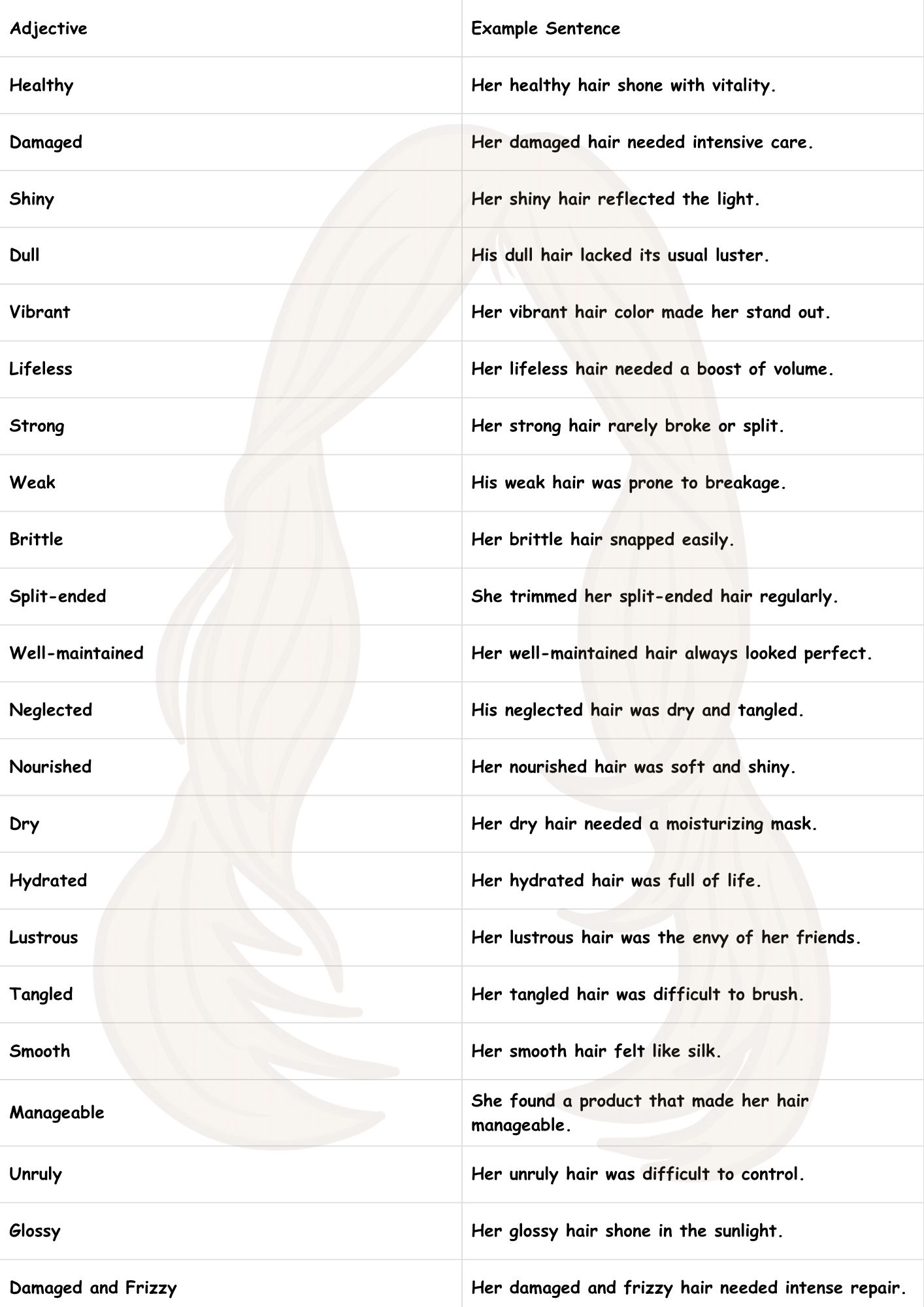
Quantity Examples
This table provides examples of adjectives describing hair quantity, showcasing their usage in sentences.
| Adjective | Example Sentence |
|---|---|
| Thick | She has thick hair that is difficult to style. |
| Thin | His thin hair was starting to recede at the temples. |
| Full | She has a full head of hair. |
| Sparse | His sparse hair made him self-conscious. |
| Abundant | She had abundant hair that cascaded down her back. |
| Voluminous | Her voluminous hair required a lot of product to maintain. |
| Wispy | She had wispy hair around her forehead. |
| Bald | He was completely bald on top of his head. |
| Balding | He was starting to go balding in his thirties. |
| Thinning | His thinning hair was a sign of age. |
| Dense | Her dense hair was difficult to brush through. |
| Plentiful | She had a plentiful amount of hair. |
| Meager | He had a meager amount of hair on his head. |
| Profuse | Her hair grew in profuse amounts. |
| Luxuriant | She had luxuriant hair that was the envy of her friends. |
| Scant | He had a scant covering of hair on his head. |
| Straggly | His straggly hair needed a good trim. |
| Patchy | He had a patchy beard and hair. |
| Tufty | He had tufty hair that stuck up in places. |
| Downy | The baby had downy hair on its head. |
| Fine and Thin | She struggled with fine and thin hair that lacked volume. |
Usage Rules for Hair Adjectives
When using adjectives to describe hair, several rules and guidelines should be followed to ensure clarity and accuracy.
- Adjective Order: When using multiple adjectives, there is a general order to follow, although it’s not always strict. A common order is: opinion, size, physical quality, shape, age, color, origin, material, type, and purpose. For hair, the order is often flexible, but consider placing opinion adjectives first (e.g., “beautiful long brown hair”).
- Hyphenation: Compound adjectives (two or more words acting as a single adjective) should be hyphenated when they come before the noun (e.g., “shoulder-length hair”). When they come after a linking verb, they are not hyphenated (e.g., “Her hair is shoulder length”).
- Descriptive Accuracy: Choose adjectives that accurately reflect the hair’s characteristics. Avoid using vague or overly general terms when more specific adjectives are available.
- Contextual Appropriateness: Consider the context in which you are writing or speaking. Formal settings may require more precise and sophisticated language, while informal settings allow for more casual descriptions.
- Avoiding Redundancy: Avoid using adjectives that repeat or overlap in meaning. For example, “very shiny lustrous hair” is redundant because “lustrous” already implies shininess.
Exceptions and Special Cases:
- Some adjectives, like “natural,” can have multiple meanings depending on the context. Be sure to use them in a way that is clear and unambiguous.
- Cultural differences may influence the perception and description of hair. Be mindful of these differences when describing hair in diverse contexts.
- Figurative language, such as metaphors and similes, can be used to create more vivid and imaginative descriptions of hair. However, use these techniques sparingly and appropriately.
Common Mistakes with Hair Adjectives
Several common mistakes can occur when using adjectives for hair. Being aware of these errors can help you avoid them and improve your writing and speaking skills.
| Incorrect | Correct | Explanation |
|---|---|---|
| She has a long hair. | She has long hair. | “Hair” is generally an uncountable noun, so it doesn’t take the indefinite article “a” unless you’re referring to a single strand. |
| Her hair are blonde. | Her hair is blonde. | “Hair” is treated as a singular noun in most contexts, so it takes a singular verb (“is”). |
| He has hairs curly. | He has curly hair. | Adjectives usually come before the noun they modify. |
| Her hair is very shine. | Her hair is very shiny. | “Shine” is a verb or a noun; the correct adjective form is “shiny.” |
| She has shoulder length’s hair. | She has shoulder-length hair. | Compound adjectives like “shoulder-length” are hyphenated when they precede the noun. The possessive form is incorrect. |
| The hairs were brown. | The hair was brown. | Referring to the collective mass of hair on someone’s head, “hair” is singular. |
| She has a curly hairs. | She has curly hair. | “Hair” is generally uncountable, and the adjective should precede the noun. |
| Her hairs are long. | Her hair is long. | “Hair” is typically treated as a singular noun. |
| He has black color hair. | He has black hair. | “Color” is redundant when “black” already indicates the color. |
| She has very shine hair. | She has very shiny hair. | “Shine” is a verb; the adjective form “shiny” is needed. |
Practice Exercises
Test your understanding of adjectives for hair with these practice exercises.
Exercise 1: Fill in the Blanks
Fill in the blanks with the most appropriate adjective from the list provided.
(List: blonde, long, curly, dry, styled, thin, red, short, wavy, shiny)
| Question | Answer |
|---|---|
| 1. She has ________ hair that reaches her waist. | long |
| 2. He prefers to keep his hair ________ and manageable. | short |
| 3. The child had ________, bouncing curls. | curly |
| 4. Her ________ hair shimmered in the sunlight. | shiny |
| 5. She has ________ hair that she often wears in braids. | wavy |
| 6. Her ________ hair needed a moisturizing treatment. | dry |
| 7. The actress had ________ hair for the premiere. | styled |
| 8. She dyed her hair a vibrant ________. | red |
| 9. His ________ hair was starting to recede. | thin |
| 10. The girl had ________ hair and blue eyes. | blonde |
Exercise 2: Identify the Adjective
Identify the adjective describing hair in each sentence.
| Question | Answer |
|---|---|
| 1. She has flowing, black hair. | flowing, black |
| 2. His short hair was neatly combed. | short |
| 3. The model had silky, blonde hair. | silky, blonde |
| 4. Her red, curly hair stood out. | red, curly |
| 5. He admired her auburn hair. | auburn |
| 6. The woman with ginger hair smiled. | ginger |
| 7. His gray hair showed his age. | gray |
| 8. She had white, long hair. | white, long |
| 9. The actor sported silver hair. | silver |
| 10. Her golden hair caught the light. | golden |
Exercise 3: Correct the Sentence
Correct the sentences below, which contain errors in adjective usage or placement.
| Question | Answer | |
|---|---|---|
| 1. She has a long hair beautiful. | She has beautiful long hair. | |
| 2. Her hairs is blonde. | Her hair is blonde. | |
| 3. He have brown color hair. | He has brown hair. | |
| 4. She has curlys hair. | She has curly hair. | |
| 5. His hair are very shine. | His hair is very shiny. | |
| 6. She has shoulder length’s hair. | She has shoulder-length hair. | |
| 7. He has a short hairs. | He has short hair. | |
| 8. Her hairs are silky. | Her hair is silky. | |
| 9. The hair were blonde. | The hair was blonde. | |
| 10. She has wavy and long hair beautiful. | She has beautiful long wavy hair. |
Advanced Topics: Figurative Language and Nuance
Beyond basic descriptions, adjectives for hair can be used with figurative language to create more evocative and nuanced portrayals. Metaphors, similes, and personification can add depth and emotional resonance to your descriptions.
- Metaphors: A metaphor compares hair to something else, implying a similarity without using “like” or “as.” For example, “Her hair was a cascade of moonlight” suggests the hair is silvery and flowing.
- Similes: A simile uses “like” or “as” to make a comparison. For example, “Her hair was as dark as midnight” emphasizes the deep black color of the hair.
- Personification: Personification gives human qualities to hair. For example, “Her hair danced in the wind” suggests movement and liveliness.
Nuance and Subtlety:
Choosing the right adjective can convey subtle differences in meaning. For example, “unkempt” and “messy” both describe hair that is not neatly styled, but “unkempt” suggests neglect, while “messy” can imply a deliberate or casual style.
Cultural and Contextual Considerations:
The perception and description of hair can vary across cultures. What is considered beautiful or desirable in one culture may not be in another. Be sensitive to these differences when describing hair in diverse contexts. Additionally, the formality of the situation can influence your choice of adjectives. A formal description might use precise and sophisticated language, while an informal description can be more casual and expressive.
Frequently Asked Questions
What is the best way to describe someone’s hair?
The best way to describe someone’s hair depends on the context and the level of detail you want to provide. Start with the basics like color and length, then add details about texture, style, and condition. Use specific and descriptive adjectives to create a vivid picture.
Can I use multiple adjectives to describe hair?
Yes, you can use multiple adjectives to describe hair. Just be mindful of the order of adjectives and avoid redundancy. A common order is: opinion, size, physical quality, shape, age, color, origin, material, type, and purpose, but this can be flexible.
Is it okay to use subjective adjectives like “beautiful” or “ugly” to describe hair?
Yes, it is okay to use subjective adjectives, but remember that beauty is subjective. What one person finds beautiful, another may not. Use subjective adjectives sparingly and be mindful of your audience.
How do I describe hair color accurately?
Use specific color adjectives like “auburn,” “chestnut,” or “platinum blonde” instead of general terms like “brown” or “blonde.” You can also use similes or metaphors to compare the hair color to something else, like “hair as dark as midnight.”
What are some adjectives to describe hair that is in bad condition?
Adjectives to describe hair in bad condition include: damaged, dry, brittle, split-ended, lifeless, dull, tangled, and unruly.
How can I avoid being offensive when describing someone’s hair?
Be respectful and avoid making negative or judgmental comments about someone’s hair. Focus on describing the hair’s characteristics without implying that one type of hair is better than another. Be mindful of cultural differences and avoid stereotypes.
Are there any adjectives that should be avoided when describing hair?
Avoid using adjectives that are offensive, discriminatory, or perpetuate stereotypes. Also, avoid using overly general or vague adjectives that don’t provide any meaningful information.
Conclusion
Mastering the use of adjectives for hair can significantly enhance your descriptive abilities. By understanding the different categories of hair adjectives—color, length, texture, style, condition, and quantity—and following usage rules, you can paint vivid and accurate pictures with your words. Avoiding common mistakes and exploring advanced techniques like figurative language will further refine your skills. Whether you are writing creatively, communicating professionally, or simply expressing yourself in everyday conversation, a rich vocabulary of hair adjectives will prove to be a valuable asset.

